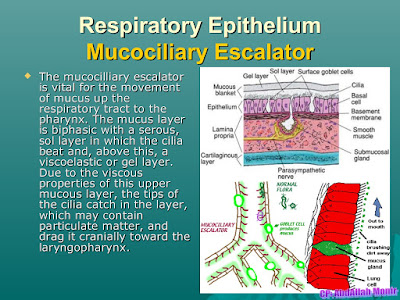CHRONIC BRONCHITIS

Chronic Bronchitis : Inflammation and swelling of the lining of the airways, leading to narrowing and obstruction generally resulting in daily cough. Chronic Bronchitis - Muco-ciliary escalator In heavy smoker ➝ Tar ↓ Ciliary damage ↓ Failure of muco - ciliary escalator ↓ Stasis of secretion ↓ infection ↓ Pus ↓ Occlusion of respiratory bronchiole Leading to underventilation of alveoli ↓ Very severe hypoxia ⟶ Central Cyanosis (↓↓ PO2) Increased pCO2 ➝ Narcosis , sleeping period increase , weight gain - 'BLUE BLOATERS' Clinical Feature : Wheel chair bound patients Type 2 Respiratory failure Respiratory acidosis Bronchorrhea central cyanosis On Examination : Increased Respiratory Rate Accessory muscles overactivity , subcostal recession Pursed lips, Central Cyanosis(blue bloater) Halitosis Clubbing absent Both inspiratory and expiratory Ronchi Hemoptysis is absent Work up : Spirometry Chest X ray - increased Broncho vascular markings(dirty lungs) IOC - HRCT ABG - Type 2 Respira


